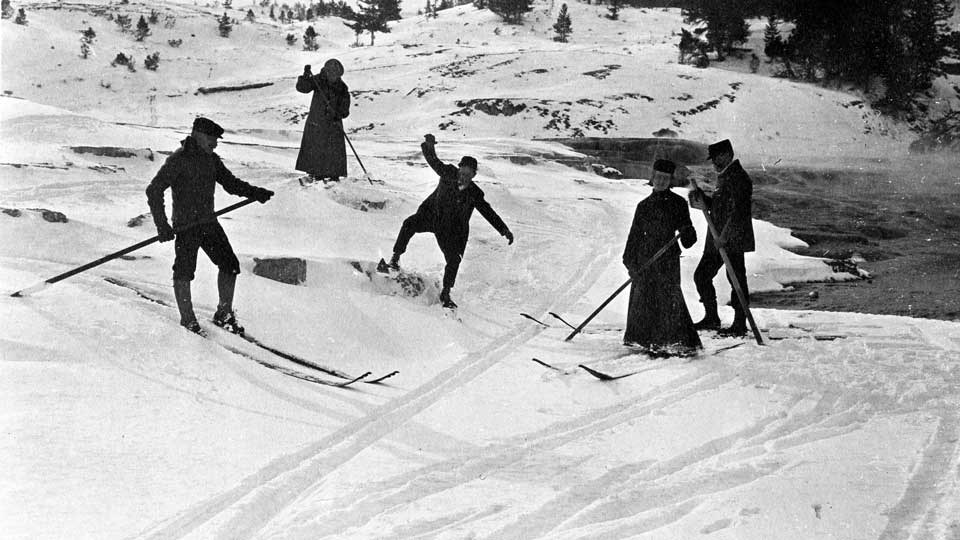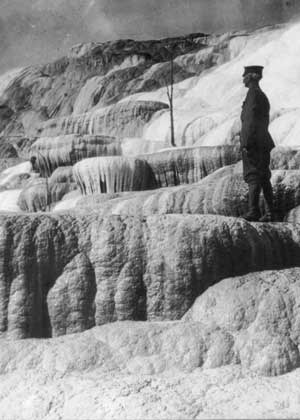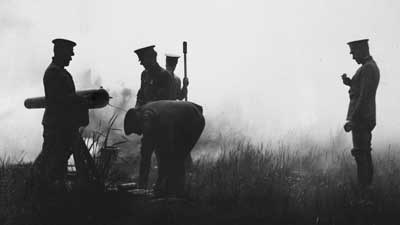Last updated: February 15, 2024
Thing to Do
Explore the Fort Yellowstone Historic District

This tour gives you a chance to explore a part of the beginning of the world's first national park. Most of the buildings constructed during the Army era are still standing and used by the National Park Service as park headquarters or employee housing.
For those physically doing the tour, remember that employee residences are not open to the public. Please respect the privacy of residents by staying on the paved route and treating living areas with courtesy.
Most buildings are not open to the public, still being used as offices or housing for employees. The buildings that are open have accessible ramps.
Wildlife are often on the grounds. Always keep your distance from wildlife, as they can be dangerous. This often means going back the way you came or finding an alternate route down a different path or road.
The Beginnings
For the decade after Yellowstone National Park was established in 1872, the park was under serious threat from those who would exploit, rather than protect, its resources. Poachers killed animals. Souvenir hunters broke large pieces off the geysers and hot springs. Developers set up camps for tourists near hot springs, along with bath and laundry facilities in the hot springs.
In response, civilian superintendents were hired to preserve and protect this land. Their experience and intentions varied, and they were all under-funded and under-staffed. Word got back to Congress that the park was in trouble, but legislators refused to appropriate any funds for the park’s administration in 1886.

The Army Years 1886–1918
Yellowstone National Park turned to the US Army for help. In 1886, men from Company M, First United States Cavalry, Fort Custer, Montana Territory came to Yellowstone under the command of Captain Moses Harris. They began what would be 32 years of military presence in the park.
At first, the soldiers lived in temporary frame buildings at Camp Sheridan at the foot of the Mammoth Hot Springs Terraces. After enduring five cold, harsh winters, the Army realized there was no end in sight to this assignment. Therefore, in 1890, Congress appropriated $50,000 for a permanent post.
The first buildings of Fort Yellowstone, at the far end of the street from today’s Albright Visitor Center, were finished by late 1891: two duplex officers’ quarters, a guardhouse, and a headquarters building on the front row; a barracks on the second row; a stables on the third row; and two non-commissioned officers’ quarters in the final row. An almost identical set of buildings was finished in 1897 to house a second troop.
In 1909, Scottish stonemasons began constructing seven large sandstone buildings using standard military plans in the Colonial Revival style. The buildings represent the Army’s attempt to live up to a substantial commitment and to provide a model post for visitors. The stone for these buildings was obtained from a quarry between the Gardner River and the Mammoth Campground.

Life at the Fort
In 1910, at the height of the Army’s presence in Yellowstone, there were 324 soldiers here—plus some families and numerous civilian employees. These troops staffed Fort Yellowstone and the park’s outposts. From these outposts, the cavalry patrolled the park by horse in summer and on skis during the winter, stopping at patrol cabins along the way.
Tourist season provided company for the officers, who entertained visitors, friends, and house guests. Carriage rides and picnics took place during the warm months, and sleigh rides and ice skating were favorite pastimes during the cold months.
There was much socializing, particularly among the officers’ families; lunches and dinners together were common. With domestic help, these social events weren’t a problem for the high-ranking officers—but a lot of work for the wives of lower-ranking officers who could not afford staff. The isolation of the fort was softened in the summer by this busy social schedule.
Children usually went to school at the fort. Teachers were found among the soldier ranks when possible. Otherwise, families with children paid the expenses of a civilian teacher. In 1910, when no teacher could be found, the children were sent to relatives and friends to attend school.
One of the challenges of fort life was keeping supplies on hand. The wife of Captain F. J. Arnold wrote:
We ordered staples, meats, canned goods, bread, etc. from the Commissary and the order would be delivered and put in the kitchen. For special occasions in the winter, we would put in a special order for turkey and then hang it outside to keep it frozen as we only had a large icebox on the back porch.... The four-horse freight wagons hauled hay and coal up from Gardiner, and many other supplies came on the market wagon. There were some fresh foods available at Hall’s Grocery store and the Van Dyke’s Meat Market....
Clothing and household items were usually ordered by catalog and some things were purchased through the PX (Post Exchange). Whittaker’s store near the Mammoth Hotel had novelties and many smaller items, and the Post Office had sundries as well.
Enlisted men spent their free time in a number of ways. Most weren’t married—the Army discouraged marriage among enlisted men and seldom provided allowances or rations for their families—so they had plenty of free time and few ways to spend it. They could visit the gym or bowling alley, or play cards.
As soon as the first heavy snow fell, the entire community donned skis. Some sidewalks were kept shoveled, but anyone wishing to go elsewhere had to ski. The porches of the officers’ quarters were lined with graduated collections of skis—from long to medium, short to very short—and the officers bought new skis regularly for their children, just as they did new shoes.
Clippings from The Army and Navy Journal report on post social life in those days:
Capt. and Mrs. Arnold received the officers and ladies of the post at noon on New Year’s. Eggnog and refreshments were enjoyed.... The Post Exchange is open again for basketball and [roller] skating. A railing has been built around the gymnasium, protecting the heaters and lending assurance to the skaters.... To celebrate the holidays, the soldiers gave a dance at the Post Exchange, which was attractively decorated with Christmas trees and flags.

Law & Orders
The buildings of Fort Yellowstone are a testament to the long history of our first national park and of the important role the Army played in preserving it for the future. They remind us that the resources we find within Yellowstone’s boundaries are not only natural ones, but cultural as well. Our interactions with this wilderness continue to shape our idea of what a national park should be, just as they did during the days of Fort Yellowstone.
Some soldiers considered Yellowstone to be a good duty station. The men of the “snowshoe cavalry” liked their rough life in the remote recesses of the mountains and some applied freely for service at these outposts. The life was demanding and often isolated, rugged, and dangerous—and very different from what most of them had known in other postings. Fort Yellowstone’s facilities were better than most and discipline was more relaxed—especially in the field.
Most of the recruits came here from dusty, hot, duty in the Southwest or western plains. Yellowstone’s weather was quite a change, and a relief in many ways. Some had never seen mountains or snow, and they had much to learn. For some enlisted men the change was too much. In 1907–08, there were 67 desertions—mostly tied to the isolation of Fort Yellowstone—and many soldiers viewed the combination of civil and military duties with disfavor.
Edwin Kelsey, who served in Yellowstone in 1891, later became the editor of the San Francisco Chronicle. Private Kelsey’s letters to his niece describe a difficult but enjoyable life:
Riverside Station, December 3, 1898... Left here for the Post [Fort Yellowstone] the Sunday before Thanksgiving.... I made 26 miles the first day, staying all night at Norris Station. The next morning it was 22° below zero, but I pulled out for the Post, which I reached about two p.m. after a cold hard ride of 20 miles. It is not so much sport riding when the snow is so deep that your horse has to work all the time. Stayed at the Post for Thanksgiving dinner and it was a beaut. The cook more than threw himself. Turkey, roast pork, sweet spuds, cranberry sauce, oyster stew, chocolate, three kinds of cake, pie, pickles, nuts and apples—how’s that for soldiers? ... There is something about this life in the wilderness that fascinates me. I saddle my beast, and go o on long rides through the forest where everything is so quiet that one can almost hear the solitude.... Love to all the family and Mable, and regards to friends, Edwin.
Ten cavalry units served at Fort Yellowstone during the 30 years—troops from the First, Third, Fourth, Fifth, Sixth, Seventh, Eighth, Eleventh, and Thirteenth cavalries, and an experimental unit of men selected for their particular skills in mountain living.
George Anderson, the third military superintendent, wrote in 1897:
As a consequence of their good work, the beauties of the park are no longer defaced; no res have ravaged the forests; poaching has diminished to a small percentage of what it was ten years ago; and more than all, order exists everywhere.
Until passage of the Yellowstone National Park Protection Act (also called the Lacey Act) in 1894, the only provision for law enforcement was the Organic Act that established the park and this only allowed for the expulsion of trespassers. Any poachers or tourists caught committing a serious infraction were marched to Fort Yellowstone afoot escorted by mounted soldiers. Often their possessions were left at a different entrance to the park so that the miscreant had to travel around the outside of the park to retrieve his belongings.

A Job Well Done
Charles Dudley Warner, correspondent for Harper’s New Monthly Magazine wrote in 1896:
The Interior Department made stringent rules, with adequate penalties for their infraction, and the military arm in command has enforced them splendidly. The good citizen rejoices that there is at least one spot in the United States where law is promptly enforced. In this respect Yellowstone Park is a moral lesson of the highest value to the United States... the whole country will have reason to be proud of the Yellowstone Park and its condition.
In 1916, when Congress created the National Park Service, the Army turned Fort Yellowstone over to the new agency. Local resistance made this transition difficult, and the Army returned in 1917. The park was fully under National Park Service control in 1918, and the Army departed. The fort has served the park well, both as administrative headquarters and as a constant reminder of the debt the nation owes the officers and enlisted men of the US Army for protecting and preserving Yellowstone National Park for future generations.
